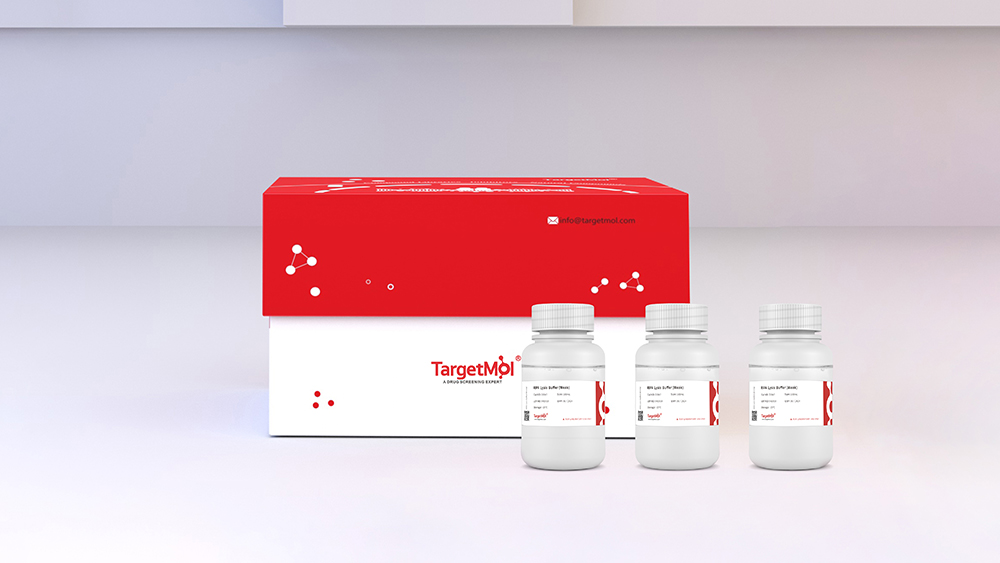 Your shopping cart is currently empty
Your shopping cart is currently empty


RIPA Lysis Buffer (Weak)
The main components of a weak RIPA lysis buffer include 50 mM Tris (pH 7.4), 150 mM NaCl, 1% NP-40, 0.25% sodium deoxycholate, and sodium orthovanadate, sodium fluoride, EDTA, leupeptin, and many other inhibitors. However, our RIPA lysis buffer does not contain all of the components of a protease/phosphatase inhibitor Cocktail. To effectively prevent protein degradation, adding PMSF or Protease/Phosphatase Inhibitor Cocktail is recommended.
| Pack Size | Price | USA Warehouse | Global Warehouse | Quantity |
|---|---|---|---|---|
| 100 mL | $80 | - | In Stock |
 Detection Principle
Detection Principle
The principle of RIPA lysate is to utilize the various chemicals in its composition to disrupt cell and nuclear membranes, thereby releasing proteins and other cellular components from the cell.
 Operation Manual
Operation Manual
1. Lysing cell or bacterial yeast samples
Melt the RIPA lysis buffer and mix well. Take an appropriate amount of buffer and add PMSF within minutes before use to give a final concentration of 1 mM PMSF, or add an appropriate amount of protease/phosphatase inhibitor Cocktail as needed for the experiment. Place on ice for manipulation.
1)For adherent cells: remove the culture medium and wash 2 times with PBS, saline or serum-free medium (skip the washing if the protein ). Add RIPA buffer 150-250 μL per well on a 6-well plate. Repeatedly aspirating and dispensing the liquid using a pipette to ensure thorough mixing. Leave on ice for 5-10 minutes, meanwhile, swirl the plate 3-4 times for 30 seconds each time to lyse the cells fully.
2)For suspended cells: collect cells by centrifugation and gently vortex or flick the bottom of the tube to disperse the cells as much as possible. Add lysate according to the ratio of 150-250 μL of lysate per cell per 6-well plate and flick the bottom of the tube to fully lysed cells. There should be no obvious cell precipitation after full lysis. If the amount of cells is large, it is necessary to split into 0.5-5 × 106cells/tube before lysis. Leave on ice for 5-10 minutes, during which time it may be shaken 3-4 times for 30 seconds each time to fully lysed.
3)For bacteria or yeast: For 1 ml of bacteria or yeast solution, centrifuge to remove the supernatant, wash once with PBS if necessary, and gently vortex or flick the bottom of the tube to dislodge as much of the bacteria or yeast as possible after sufficiently removing the liquid. Add 100-200μL of lysis solution, gently vortex or bouncing the bottom of the tube to mix well, and lysed on ice for 2-10min. If you want to get better lysis effect, bacteria and yeast can be digested with lysozyme and wall-breaking enzyme respectively, and then lysed with the lysis solution.
4)After sufficient lysis, centrifuge at 10,000-14,000g for 3-5 min, take the supernatant, and then proceed to the subsequent PAGE, Western and IP operations, or use liquid nitrogen to freeze and put -80°C for long-term storage.
2. Lysing Tissue Samples
1)Mince the tissue into small pieces.
2)Melt the RIPA lysis buffer and mix well. Take an appropriate amount of buffer and add PMSF within minutes before use to make a final concentration of 1 mM PMSF, or add an appropriate amount of protease/phosphatase inhibitor Cocktail as needed for the experiment.
3)Add RIPA Lysis Buffer to the tissue at the ratio of 150-250 lysis buffer per mg of tissue. (For incompletely lysed tissues, the volume of RIPA Lysis Buffer can be increased. For samples with high protein concentration, the volume of RIPA Lysis Buffer can be reduced.)
4)Homogenize on ice with a glass homogenizer 30-50 times or sonicate the tissue for 30 seconds 3-4 times at 1 minute intervals on ice for cooling. Then visually inspect the sample. The cell rupture rate should be no less than 90%, and the tissue should be completely lysed without obvious fragments. Transfer the homogenate to a tube and keep on ice for 5-10 minutes, shaking it 3-4 times for 30 seconds each time to ensure thorough lysis.
5)After sufficient lysis, centrifuge at 10000-14000g for 3-5min, take the supernatant, and then proceed to the subsequent PAGE, Western and IP operations. The supernatant obtained after every 20mg of frozen mouse liver tissue with 200 uL of this lysate may yield 15-25 mg/mL protein. Different tissues in different states vary.
 Storage Condition
Storage Condition
Stored at -20°C 12 months.
 Precautions
Precautions
1.Avoid multiple freeze/thaw cycles. It is recommended to aliquot the samples for future use.
2.This product contains some inhibitors that partially inhibit protein degradation, but does not contain PMSF or protease/phosphatase inhibitor cocktails.
3.Add tissues directly to the lysis buffer after appropriate shearing If the tissue itself is very small, and thoroughly lyse the samples by vortexing vigorously. Then centrifuge and collect the supernatant for further experiments. Direct lysis is more conveniente, as it eliminates the need for homogenizers or grinding equipment, but it may not achieve as thorough lysis as homogenization or grinding.
4.All steps should be performed on ice.
5.The SDS in the lysis buffer may precipitate at 4°C. Completely redissolve the buffer by heating in a 37°C water bath to return to room temperature before use.
6.RIPA Lysis Buffer contains ionic detergents and may not be suitable for some kinase enzyme assays.
7.Do not add phosphatase inhibitors when preparing lysates for phosphatase assays
8.This product is for R&D use only, not for diagnostic procedures, food, drug, household, or other uses.
9.It’s advisable to wear a lab coat and disposable glove.
 Instruction Manual
Instruction Manual
Keywords
| Size | Quantity | Unit Price | Amount | Operation |
|---|

Copyright © 2015-2025 TargetMol Chemicals Inc. All Rights Reserved.



